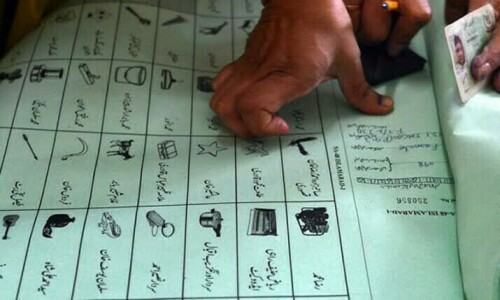Miftah Ismail
Former finance minister

Pakistan used to be the richest country in South Asia. Today, it is near the bottom, with India, Bangladesh, and Sri Lanka far ahead. Our government’s tax and expenditure policies haven’t catered to our people’s economic welfare for decades. But then, neither have our education, health, or other policies. Therefore, we need to fundamentally change our governance. This budget, the first for the new government, was a chance to alter the course of our downward trajectory. In that, it has failed.
The budget is good for governments and legislators. National Assembly members get Rs75bn worth of new projects, legislators in provinces are likely to get upwards of Rs300bn, and federal and provincial governments get to spend Rs3.8tr in so-called development spending. And we pay for their bonanza with taxes on infant formula and packaged milk and increased taxes on salaried employees — by the same amount, whether you are making Rs500,000 or Rs2m a month!
While salaried employees and the middle-class are being squeezed, there isn’t any belt tightening by the government. In a display of its priorities, the government has imposed taxes on books, stationary, and heart stents while increasing its current expenditures, net of debt servicing, by 24pc.
Mosharraf Zaidi
Founding partner, Tabadlab

Even in the age of populism, budgets remain the most profound expression of politics and political will. What adjectives can aptly describe the politics and political will expressed in the FY25 budget that this government has just announced? Farcical may be too harsh. Every year, the federal PSDP (the portfolio of “development” or capital investments the government intends to make) is a large and unrealistic number. And every year, the actual money spent under the PSDP is tens, nay, hundreds of billions less than what is allocated. The PML-N government allocated Rs975bn for the federal PSDP last year. Actual spend was barely Rs400bn. So what did the same PML-N government do in this budget? It ramped up the PSDP to a dizzying Rs1,400bn.
Daronomics has been firmly entrenched since last year — and the caretaker government doubled down on key pillars of the Dar approach to economic management. Muhammad Aurangzeb has made a brave attempt to lead reform, and shoulder responsibility — but the visible hand of Dar has stymied him on both fronts. The result is a nothingburger of a budget. This, apparently is how Pakistan does fiscal consolidation. Some set piece favourites are back: exemptions have been removed (they’ll roll over on this), BISP has been given a higher allocation (it should be even higher) and government employees, civil servants and government pensioners have been upgraded on flight never-ending-gravy-train.
SalIm Raza
Former SBP governor

Commentary following the budget has been mixed. Penalties on non-filers, such as restriction of travel without an NTN, the widening of digitisation of all payments, and charging some ‘holy cows’, e.g. exporters, have generally been welcomed. Criticism has centred around intensifying business-as-usual practices, i.e. tax increases for the salaried class and continual extension of unavoidable sales taxes, this time also to include food items — without really stretching the net to capture hitherto largely ‘escaped’ income, such as on the wholesale and retail trades, agriculture income and the profit of property developers.
Relying mainly on the banking system to finance some Rs 5tr of the FY25 budget deficit, when the banks already have around 55pc of their loanable assets in government securities, further impinges on potential credit for the private sector. However, the budget simply estimates what can be collected within 12 months. The scope for raising funds is hemmed in by what a given political framework is thought to be able to allow — without breaking unstated but implicit political and social understandings. Practices will only change following political unanimity on preconditions to sustainable economic growth — where there has been a historical reluctance to grasp the nettle.
Khalid Khokhar
President, Pakistan Kissan Ittehad

Against farmers’ fears the government did not slap GST on agriculture inputs in this budget, which can only be welcomed. It will certainly breathe some life into a sector that has otherwise been facing an existential threat. The missing GST would cause the government some revenue loss. Now, it must ensure that a corresponding benefit reaches the farmers rather than being lost to the black market. It should have spared some money and policy initiatives to make markets efficient.
Farmers have lost over Rs1tr — the difference between the support and indicative price and the actual sale price in the market — on all major crops. They can hardly afford to suffer more losses.
Another area where the farmers begged for relief was electricity rates because its a federal subject. But there is no relief. It will continue to bleed the farmers white, ensuring low growth rates.
The budget also missed a long-term policy for sustainable growth to ensure food security. Pakistan’s population is growing at 2.25pc per annum, adding around 5.5m heads every year. The country needs 7pc growth rate on a sustainable basis. In order to achieve that, a 10-year sustainable agricultural policy framework should have been devised. Without such a policy, the sector will remain a season-to-season affair, generating uncertainties every six months.
Abad Khan
Member, Farmer’s Associate Pakistan

The federal budget did touch some key areas of the agriculture sector but left their details untouched. For instance, it says that taxes would be rationalised. What does that mean for the sector? Taxes are now a matter of existential importance. They can be rationalised in two ways: reduction or increase. Which way would they go? We have clues but no answers. Similarly, climate change, which again is a matter of prime importance for agriculture, is present, and again, an authority has been set up. What it will do and how much agriculture will benefit from its working is still a guessing matter.
The only direct allocation for the sector is Rs5bn for “farm mechanisation and risk sharing.” It also leaves farmers wondering what this vague head would include or exclude. Whether crop insurance would also be put under this head? All these questions are left unanswered. Farmers are a confused lot. The biggest issue that agriculture faced last year was cost of production. As the world absorbed the impact of Covid-19 and then the Ukrainian War — both pushed world commodity prices up — and prices were sliding back to pre-problem levels, cost of production kept rising.
This is the cycle Pakistani farming is going through right now. This issue needed a response, but the finance bill is silent. Instead, the response is spread among different institutions, authorities, and ministries, with key questions hanging in the air. This is called shirking of duty, not ruling the country.
Dr Iqrar Ahmad Khan
Vice- Chancellor, University of Agriculture, Faisalabad

The economic survey reveals impressive growth in agriculture thanks to better crop yields. However, that needs to be sustained. The farmer had paid higher prices for inputs and received lower-than-expected returns. That would restrict farmers’ ability to invest in the next season of crops.
The PML-N government presented the national and Punjab budgets, including a plan for investment in agriculture. The meagre agricultural share in the federal budget with direct allocation of Rs5bn for mechanisation and allocation for the water sector is being criticised.
The criticism also needs to be seen in the light of the 18th Amendment.
The Punjab government budget statement reflects a huge increase in allocation for agriculture and its allied sectors, with Rs64.6bn for crops, Rs4bn for forestry, Rs6.4bn for wildlife, Rs5.3bn for fisheries, Rs0.4bn for food, and Rs9bn for livestock and diary development.
Moreover, there is an allocation of Rs25.8bn for irrigation and Rs10bn for Environment and Climate Change, which supports agriculture. The green tractors initiative, interest-free loans for small farmers, solarisation of tube wells, model fish farms, and livestock cards are significant.However, the budgets are silent on correcting the market failures and mute on reforms in the research segments.
Syed Mahmood Nawaz Shah
President, Sindh Abadgar Board

A 62pc increase in the agriculture sector is commendable in the Sindh budget, but is for conventional expenses rather than meeting any substantive core challenges in agriculture. The increase will be diverted mostly to salaries and allocations under foreign-funded projects. The government also did not talk about controlling the cost of input coupled with declining commodity prices. Blocked and encroached natural waterways remained a matter of concern, but the government has still not addressed this issue, even though it could help drain out water in floods and ensure efficient water utilisation.
Furthermore, he underscored the need to activate the Sindh Seed Corporation (SSC) to overcome deficiencies in seed quality. He said the SSC has 6,000 acres of land but has yet to make its presence felt in the agriculture sector.
The SSC could be aligned with the private sector for some research and development-oriented measures, using biotechnology to develop seeds. Oil seed production in Sindh is not focused on in the budget, although it could work as an import substitution for edibles.
Aamer Hayat Bhandara
Progressive farmer

Establishing the Climate Change Authority will have a great impact on the agriculture sector, which suffered the most in 2022-23 because of erratic weather patterns leading to incessant rains.
If the National Digitisation Authority focuses on the agriculture sector, it will be a positive step forward because it will generate more revenue for the government as well as the farmers, preventing exploitation by the middlemen. Digitised data from agricultural markets will reveal how much farm goods changed hands and, thus, avert hoarding, tax evasion, and poor payments to the farmers.
The Kisan Card will also help in the digitisation of the sale and purchase of fertiliser, pesticides, and seeds and check the marketing of spurious and/or adulterated farm inputs. However, landless small farmers should be included into the scheme, which so far considers only owners of up to 12.5 acres of land as eligible.
The Rs9bn tube-well solarisation project will reduce the electricity tariff burden on the farmers; whereas the Rs8bn allocation made for setting up modern fish farms will promote aquaculture in the province.
Ahmad Jawad
Head of FPCCI agriculture committee

The Punjab budget is a Kisan-friendly package. By allocating a huge sum of Rs30bn, for the first time 50pc subsidy has been for tractor prices for 0.5m farmers. No, government, even the PML-N’s, has given a higher subsidy before. Tractor prices have jumped up to Rs2.2m leading to a lull in the sale of the machine for small farmers. Likewise, the Rs75bn interest-free credit facility eliminating over 20pc of the Kibor will help the smallholders to buy farm inputs well in time and without going to informal creditors like Arhtis and fertiliser and pesticide dealers for inputs on credit at highly exploiting terms.
The establishment of the Punjab Kisan Bank to meet the cash requirements of the farming community in the future will further strengthen credit availability as the Zarai Taraqiati Bank has de-tracked from its stated path and is working like other commercial banks, giving a fig to the needs of small farmers. However, abolishing the wheat and cotton support price mechanism in Punjab and replacing it with a free-market mechanism allowing the farmers to sell their produce anywhere may have been another much-needed step to improve the financial position of the sector.
Azizullah Gohir
Secretary General,
Pakistan Textile Exporters Association

The proposed budgetary measures will have devastating effects on exports and the economy, leading to factory closures and job losses. The budget makers have failed to give the necessary direction to industrial progress and export promotion.
The textile sector, an important segment of the economy, is already in the grip of a severe crisis, and industrial production is not by the built-up manufacturing capacity. Due to this underutilisation, the country is not fetching the full potential of foreign exchange earnings. But contrary to expectations, no heed has been paid to this most important sector, and the architects of the budget have failed to realise the importance of major irritations besetting the economy and outline a strategy for their solutions.
Income tax regime change from 1pc Final Tax Regime (FTR) to the Minimum Tax Regime (MTR) is unacceptable as exporters are paying income tax on turnover regardless of profit or loss. The move will increase the bureaucratic hurdles and corruption risks.
Around Rs700bn are stuck in the refund regime creating a severe financial crunch, while Rs38bn of old due refunds have not been fully budgeted. Exporters are bearing 24pc interest on the stuck-up refunds. The budget has further strained exporters’ liquidity without any measures to release the liquidity stuck in sales tax and other refund regimes.
The withdrawal of the zero rating on local supplies under the Export Facilitation Scheme (EFS) will lead to a surge in intermediate input imports. An 18pc sales tax plus turnover tax will further hit the local manufacturers, who are already struggling with high energy costs.
These changes will erode Pakistani exporters’ competitiveness in the global market, potentially leading to a decline in export revenue and foreign exchange earnings.
The government must reconsider the budgetary measures and restore exporters’ confidence by reinstating the 1pc FTR regime, restoring the zero-rating on local supplies under EFS, and allocating appropriate funds for payment of exporters’ outstanding refunds to achieve economic growth and put the economy into a lower gear.
Zafar Masud
Chairman,
Pakistan Banks’ Association

At the outset, it must be appreciated that the government has unveiled the budget 2024-25 under extremely onerous circumstances. Multiple balls have been in the air — from political considerations to IMF expectations to curtailment of cash economy to debt management and, above all, to plan economic revival and growth — and none of them can be afforded to be dropped.
In this backdrop, it’s visible that the finance minister has put his best foot forward and tried to balance the competing ambitions; thereby, establishing the stage to travel towards the eventual goal of growth and eradication of poverty.
There are some unprecedented moves in the budget like substantial removal of tax concessions and making life difficult for non-filers aiming to eliminate this category eventually that possibly would prove to be a forceful strike on the undocumented sector.
While I believe this distinction between filers and non-filers shouldn’t exist, eliminating it in one budget would have proved disruptive to the economy, which we can’t afford with our already anaemic economic growth. The effort to curb unproductive and speculative real estate activity by introducing capital gains tax and federal excise duty is commendable indeed. And so is the endeavour to register retailers and wholesalers. The plan to consolidate overlapping government divisions and departments is another key reform.
While rationalising pension expense is a great move, a better job was expected on the expenditure side, i.e. the government’s operational expenses and development programme. Rather than abruptly transitioning the export sector towards the regular tax regime, the government could have considered a staggered approach. To mitigate the unfavourable impact of swelled taxation on exports, as a better trade-off, the prime minister has announced a Rs10.69/unit cut in electricity tariff for industries. Having said that, it’s one thing to announce budget measures, and it’s another to implement them. The proof of the pudding is in its eating — relentless execution of the budgetary actions and economic revival and growth plan (homegrown that the prime minister and the finance minister keep on referring to). The capacity to stand painful reforms will be instrumental in managing liquidity risks, both on external as well as fiscal accounts.
Published in Dawn, The Business and Finance Weekly, June 17th, 2024












































Dear visitor, the comments section is undergoing an overhaul and will return soon.